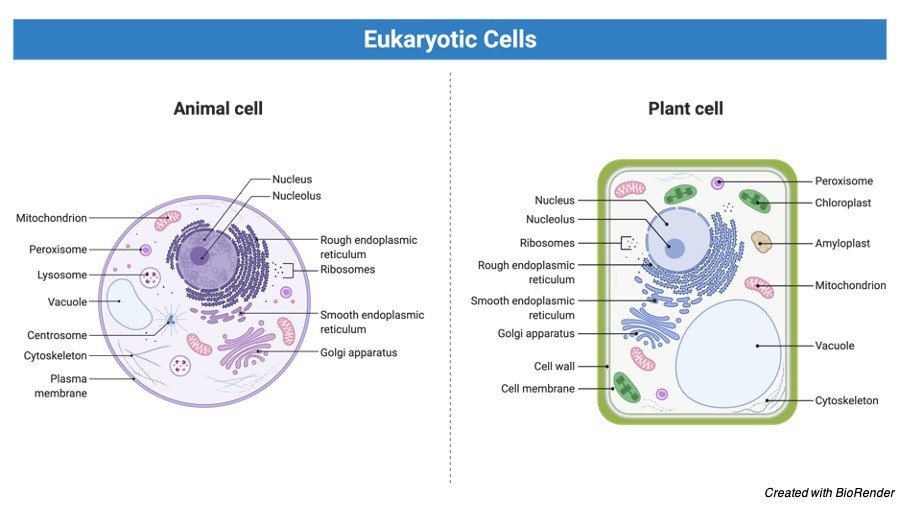What is Cytoplasm?
The cytoplasm is the ground substance present between the plasma film and core of all cells with the exception of viral cells.
It is a shapeless, clear, homogenous, colloidal substance, separated into the cytoplasmic lattice and cytoplasmic designs.
Cytoplasmic lattice, hyaloplasm, or cytosol is separated into fringe denser and non-granular parts called cortex or ectoplasm and an internal less thick and granular part called medulla or endoplasm.
It is a genuine arrangement of nucleotides, nutrients, RNAs, minerals, sugars, amino acids, and a colloidal arrangement of proteins.
Cytoplasmic designs incorporate cell organelles.
Composition of Cytoplasm
The cytoplasm is made out of a thick and liquid part, the cytosol, comprised of water (which addresses 75-85% of the complete load of the cell), of inorganic substances separated in ionic structure (particularly particles K+, Na+, Ca++ and Mg++) and from different natural atoms (counting proteins with enzymatic or primary capacity).
Eukaryote Cytoplasmic Structures
The endoplasmic reticulum is a mind-boggling organization of imparting tubules, packs, and channels, which open up at the level of the atomic film.
The endoplasmic reticulum is of two sorts; the harsh kind is a continuation of the atomic layer and conveys a large number of little granules, called ribosomes.
On the outside surface, they are connected to the blend of proteins; the smooth sort is liberated from ribosomes and is liable for lipid combination. At last, the space between the collapsed layers of the two kinds of endoplasmic reticulum is utilized to store and move particles starting with one point then onto the next in the cell.
Ribosomes are the site of protein amalgamation, i.e., the get together of amino acids to shape proteins.
They comprise of two subunits of inconsistent size, comprised of ribonucleic corrosive (RNA) and proteins.
They can be related with the harsh endoplasmic reticulum (for this situation, they combine proteins bound to be emitted outside the cell) or free in the cytoplasm (they blend proteins that the cell holds inside).

The Golgi contraption comprises of tubules smoothed in the middle and swollen at the closures, stacked on one another and finishing at the lower part of the visually impaired, where different materials (chemicals, proteins, lipids) are changed and collected, which will be shipped to different pieces of the cell or ousted.
For this reason, little vesicles disengage from the finishes of the leveled sacs and relocate towards the plasma film and converge with it; the substance of the vesicles are accordingly spilled out.
Lysosomes are vesicles that get from the Golgi contraption and contain hydrolytic compounds (fit for annihilating proteins and lipids).
The cell utilizes lysosomes to reuse worn pieces of organelles or to “digest” a whole cell (for instance, a bacterium).
Mitochondria are roundish or ovoid organelles, delimited by a twofold film; the inner one is collapsed on itself to frame septa (mitochondrial peaks), which increment the inside surface of the organelle.
The space encased by the inside film is the network, while the space between the two layers is the between layer space.
Cell breath happens in the mitochondria, through which energy is removed from supplements (sugars and fats) following their oxidation and ensuing destruction up to carbon dioxide and water.
The energy got from this cycle is put away as ATP atoms; at the suitable time, the hydrolysis of ATP makes accessible the energy fundamental for the cell to complete its exercises.
Thus, cells with an elevated capacity to burn calories (for instance, muscle cells) have a more prominent number of mitochondria; all things being equal, the red platelets are free.
A characteristic of mitochondria is simply the capacity repeat, permitted by the presence of a mitochondrial DNA, ribosomes, and every one of the particles essential for the duplication of the hereditary data.
Mitochondria, truth be told, live a couple of days and must, along these lines, be consistently created (this happens by separating vesicles with a twofold layer containing mitochondrial DNA from the crude mitochondria).
The organelles are wrapped and upheld by protein-like filaments that structure an organization, the cytoskeleton. The cytoskeleton likewise offers help for cells without an inflexible divider and has a functioning part in cell division and in the developments of the organelles and the whole cell.
The cytoskeleton is certainly not an inflexible and lasting construction since the filaments that establish it are constantly collected and dismantled.
These are partitioned into three gatherings dependent on their measurements, microfilaments (5-7 nm in width), middle of the road fibers (8-10 nm in distance across) and microtubules, empty tubules with a breadth of around 25 nm, which additionally comprise the centrioles, eyelashes, and flagella.
The centrioles are empty tube shaped constructions, comprising of 9 trios melded with microtubules, which are found in all creature cells (two for every cell) and in a couple of plant cells. The centrioles intercede during cell division to effectively disseminate the chromosomes in the two girl cells.
The eyelashes and flagella are filiform and versatile members with indistinguishable construction, 9 sets of microtubules welded to shape a ring around two focal microtubules.
They are recognized by the length and the number wherein they are available on the plasma film. The eyelashes are various and short (10-25 µm), the flagella are not many and long (50-75 µm).
Their planned developments move the cell into the general climate or make flows in the extracellular fluid that cause a consistent progression of the suspended particles.
The centrioles are organelles as an empty chamber that plays out the capacity of getting sorted out focuses of the inward design of eyelashes and flagella, and for this situation, they are called basal bodies.
Likewise, all phones have a construction called the centrosome, comprising of a couple of centrioles, which plays out a significant capacity when a phone recreates itself.
Eyelashes and flagella are exceptionally flimsy portable expansions present on the outside of numerous sorts of cells; they comprise of explicitly coordinated microtubules.
Eyelashes are hair-like limbs that have the capacity of moving extracellular liquids, however, can likewise furnish a few cells with development.
Every eyelash independently plays out a whiplash-like development, and in general, the lashes move in a state of harmony, making a wave development on the cell surface. Protozoa utilize their eyelashes both to move and to acquire food particles cytoplasm, making the particles that are found in the fluids outside the cell advance with their beat.
Cytoplasm Citations
Share









